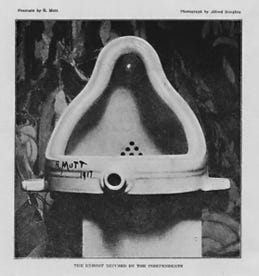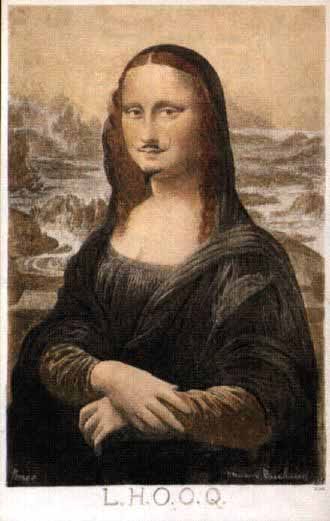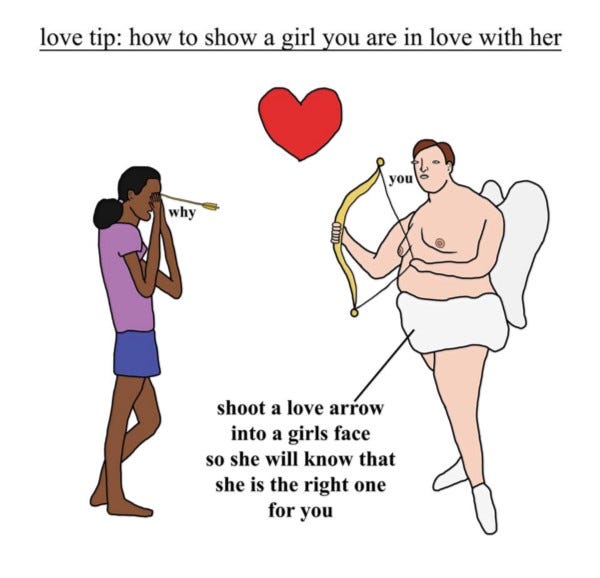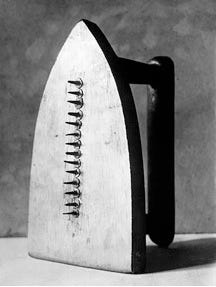Now that that’s out of the way…
The embedding of the prior video just now was a direct demonstration of absurdist humor, the latest cultural and art movement to employ elements of rejecting the traditional and embracing the strange or absurd. But wait just a minute there — what do you mean, cultural movement? And did you say art? I thought absurdist humor was just those two silly llamas in hats having a conversation, or that weird video about sitcoms that [adult swim] released last year.
It is — but, on another level, it’s so much more than that. Where most see two llamas in hats having a conversation (albeit a rather strange one), I see an insightful commentary on the traditions of duo comedy and a possible argument against meeting the expectations of fans who constantly demand more out of a creator. Where most see a confusing and, at times, disturbing video that messes with the structure of old comedy shows, I see a complex analysis of the structure of the sitcom, the structure of most stock television shows, and the constant fight between a creator of content and an editor.
Sounds pretty complicated for a bunch of weird, silly videos, huh? But this is simply one slice of the complex and rich world that absurdist humor has to offer. Not only does it provide a means for people to express their disillusionment with the world through an open and accessible medium, but it also has precedence in a widely-respected art movement called “Dada”, dating back to the First World War.
Dadaism was an art movement categorized as “defiantly anti-art”: fed up with the world and disillusioned by what it had to offer, the new generation of artists after World War I essentially said, “screw this,” and began making art that juxtaposed all that came before it. In the words of David Hopkins, Dada “sought to overturn traditional bourgeois notions of art” (xiv). Numerous art pieces grew out of this movement: the Mona Lisa with a mustache and the upside-down urinal cleverly titled, “Fountain,” to name a few.


But one of the quintessential articles that was written during the period, entitled “The Art Scab,” truly captures the essence of what Dada stood for. Jed Rasula, in his novel Destruction Was My Beatrice, describes the piece as reading “like the snarl of a rabid hound with teeth bared” (66). It contains all of “Dada’s rapier wit and its sting,” and is the summary of the “anti-art” that Dadaists created. In the words of George Grosz and John Heartfield, two Dadaists of the time:
The title ‘artist’ is an insult.
The designation ‘art’ is an annulment of human equality.
The deification of the artist is equivalent to self-deification. (Rasula 66)
The Dadaists, to some extent, didn’t view themselves as “artists” in the typical sense: they were going against the grain of societal convention, producing works that may or may not have been defined as art. But doesn’t that sound a bit familiar? The absurdist humorists of today don’t call themselves “artists” in the usual sense, either, nor do they follow those conventions of yesteryear: they draw weird pictures, like with “Simpson pictures that I gone and done,” or they make quirky videos that make no apparent sense, like “Going to the Store”. But who are these elusive artists? Who is producing this new content, and who is consuming it?

Both the artists and the consumers are largely composed of millennials, the current younger generation and one that I am a part of. This generation is fueled by a similar desire to that of the Dadaists: to address the disillusionment of our generation in relation to all of the current events we are witnessing, particularly within the United States. As Americans, we were promised to be whoever we wanted to be, and we were given high unemployment rates and no guarantee of a job after college. We were promised peace and prosperity, and we were handed terrorism and a severe economic recession. Is it truly a surprise, then, that millennials would follow in the footsteps of their precedents and craft a movement centered around absurdism and, essentially, deliberate confusion and nonsense?
The parallels between the millennials and the Dadaists don’t end there: “The Art Scab” does not only capture the essence of the Dadaists’ movement, but the millennials’ as well. Millennials exude that same “rabid hound” attitude — when we speak up about an issue or about our own disillusionment through a form of absurdist humor, we don’t do it quietly, or with passivity. We have our “teeth bared”, we snarl, we let our anger and our frustration fuel us and drive us forward. Why else would we create Tumblr bath bomb posts but to complain and bitterly call out aesthetic posts that hold no clear meaning? Why else would someone slap eggs on themselves but to create a satire of tutorial videos that are perhaps far too prevalent on the Internet today?
Absurdist humor is a means to express the core disillusionment that lies at the heart of the millennial generation, just as Dada art was a way to express the frustration toward the state of the world after World War I. If this is assumed to be true, then can absurdist humor be classified as a movement, let alone an art movement? One of the things that classifies a movement is the title itself — it must move from place to place, spreading nationally, or even globally, in a culturally-impactful way. Absurdist humor is definitely moving places, but it isn’t moving through cabarets and museums, as Dada art was — instead, it’s moving across the cloud of the Internet. The Internet has served as the primary medium through which absurdist humor has been distributed, due to the very structure of the Internet itself allowing for interactivity across multiple platforms and for the ability to create in multiple mediums. Where else could HowToBasic’s or even Adult Swim’s odd, short videos flourish but on YouTube? Their respective videos have millions of views each, and all thanks to the sharing power that the Internet is able to offer.
As for whether absurdist humor can classify as art, it’s uncertain — it largely depends on what your definition of art is. That definition could be pretty cut-and-dry and taken straight from the dictionary, or it could be more complex than that when one takes into consideration mediums that may lie outside the traditions of paint or sculpture. Absurdist humor certainly lies outside of those definitions — the mediums by which it is produced are untypical of previous art movements, as it frequently uses Internet mediums like YouTube or Tumblr to share its content, and those mediums themselves are much younger than those prior, more traditional methods.
Dada artists themselves, while still using conventional art forms like sculpture, also broke the barrier in using other, newer forms of art: Man Ray, one of the Dadaists, once made an art piece entitled “Gift” while he was out meeting the composer Erik Satie for the first time. The two had gone out for a drink, and on their way back, Man Ray stopped at a hardware store, bought some tacks, glue, and a flatiron, and stuck the tacks to the flatiron with the glue, giving it to Satie as a “gift”, as the title shows (Rasula 183).

This piece, shown above, is the perfect example of an art form that defies convention — one could classify it as a sculpture, but couldn’t it also be classified as found art? I could probably produce a similar piece in no time at all — does that still make this art? Is it truly art at all?
Critics back in the day of Dada certainly thought so — or, at least, were forced to think so and acknowledge Dadaism for what it was, according to Arndt Niebisch: “if critics would have rejected Dada as mere nonsense, they would have been in danger to appear as very stupid, if Dada should finally have emerged as the new all-encompassing wisdom” (41). The critics were trapped: if they condemned Dada, there was the possibility that they would later lose their reputation and even their career as an art critic. The large majority of critics thus felt obligated to at least be aware of Dada and what these artists were producing. However, there was a small number of “cultural critics” that attacked Dada, calling themselves “Antidadaists” and dismissing the movement outright (Niebisch 41). These types of critics echo the dismissal absurdist humor often receives today — absurdist humor isn’t widely regarded as a movement, nor is it regarded even as art. It’s, instead, viewed as “trite,” perhaps, or as a fad that those millennials will get over any day now. There is basis for this viewpoint, of course — who really looks at a couple of weird Internet videos and declares it to be the peak of cultural value? It’s silly, it’s strange, and it certainly doesn’t classify as art by any traditional standards.
But absurdist humor has just as much right as its predecessor, Dada, to be considered — perhaps not as art, yet, but as something with the potential to become art. It’s breaking new ground as Dada once did, and so it might yet come to be viewed as art in the future. In the meantime, we can at least agree on this: absurdist humor is a movement that is taking the Internet, and the millennial generation in particular, by storm as Dada once did with its own “millennial” generation, and even if it isn’t strictly “art,” it is certainly providing an avenue down which people are creating and sharing their interpretations of the world around them.
So what if some millennials are making weird videos and pictures, and others, like me, are equating the whole process to an art movement — why should this matter at all? Ultimately, art movements, like Dada, are studied because of their cultural significance. As the collective human race, we can never simply leave our history behind and move on to see what the future holds. No — we feel obligated to be aware of what came before us so as to find precedents for the here and now and to examine how we used to be, anywhere from ten years to a thousand years ago. Absurdist humor is one of those culturally-significant concepts that has served as the product of precedents and generations moving forward, from the older generations to the now millennial generation. Past generations have enjoyed family sitcoms as their sources for humor, for example, implicitly identifying their cultural values as having to do with family and spending time with them to connect and form lasting bonds. The millennial generation, in contrast, enjoys the absurd and the weird, implying that they may value the willingness to profess one’s viewpoint, or perhaps the ironic or satiric approach to viewing life and the problems we all face on a daily basis.
Either way, absurdist humor is slowly becoming a precedent for what may come down the line of history — it’s already shown us how it may have evolved over time from both Dada and from generations’ changing values and interests. Now, who knows what will happen? Will it remain in our culture as an integral piece of how we, especially millennials, communicate? Will it evolve into a new form of humor, one we cannot even begin to predict? Or will it simple fade out of our minds, its own impermanence letting it drift away over time?
Absurdist humor isn’t truly meant to have staying power in the first place — the inherent nature of absurdism is its impermanence, and its humor lasts only as long as there is a generation to laugh at it and produce additional content. Dada wasn’t a permanent force, either — it was an art movement that came and went within a matter of years and then became a weird part of history, albeit one that we still study today. Why, then, should absurdist humor last, if no other art movement truly does?
Somehow, almost improbably, absurdist humor has integrated itself deeply into our culture and society as a whole over the past few years that, now, its permanence in some form becomes a distinct possibility. The permanence that absurdist humor may exhibit in the coming years may be equivalent to an evolution, though — a change in the outer appearance of what we view as absurdist humor, but a continuation of its core nature of unexpectedness and, well, absurdity. The Internet, the tool by which absurdist humor has flourished, can further serve as the means by which this staying power will come into play. The ever-changing state of the Internet, combined with its ability to archive, creates the perfect environment for both relative permanence and evolution.
Absurdist humor, it seems, then, isn’t going anywhere, no matter if it’s an art movement or just a silly phase we’re all going through. It has, essentially, become a new form of Dada — “neo-dadaism,” we could call it — and regardless of how long it will last, it has certainly already made its impact on the world and on our culture in particular. And on that note, I’d like to remind you of a little something:
Works Cited
Hopkins, David. Dada and Surrealism: A Very Short Introduction. New York: Oxford University Press, 2004. Print.
Niebisch, Arndt. Media Parasites in the Early Avant-Garde: On the Abuse of Technology and Communication (Avant-Gardes in Performance). New York: Palgrave Macmillan, 2012. Google Book Search. Web. 19 February 2016.
Rasula, Jed. Destruction Was My Beatrice: Dada and the Unmaking of the Twentieth Century. New York: Basic Books, 2015. Print.
